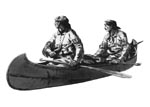

The
Bark Canoe Store
15 East Sinto
Spokane, WA 99202
(509)327-7902 (office)
(509)327-1850 (shop)
(509)327-7989 (fax)
barkcanoe@earthlink.net
www.barkcanoe.com
John Lindman
proprietor/builder
Copyright (c) 2006
All Rights Reserved
IN THIS ISSUE
1. News -
2. Building Tip -
More on Miniatures by Ted Behne
News -
New Movie
"The War That Made America" was aired on PBS several weeks ago. I didn't find out about it until it was over. Just the other night I watched it for the first time. It tells of the events leading up to, through and shortly after the French and Indian War. It is a well told story in significance, pacing, and visual aspect. To find out more about it or to order the video go to
Four birchbark canoes were shown in the movie. Two were made by students in our class. The owner of one canoe, Tony Di Orio,
was the canoe wrangler for those two canoes. One was shown in the scene where a white captive, Mary Jamison, was being
paddled to her new home. The other scene shows both canoes when young George Washington was speculating for land in the
Ohio country.
I found the movie enjoyable and educational and perhaps you will too.
Building Tip - More on Miniatures by Ted Behne
Unrolling and Raising the Bark - Part Two
This article continues the process of setting up the bark to begin the assembly process. Assembly constitutes about
50 percent of the work in making a canoe, so at this point you are about half way home. Previous articles outlined
other basic steps. These include: Selecting a canoe to model; making a quarter-scale "blueprint"; constructing a
reusable building platform; making a gunwale frame; making and installing thwarts; making ribs; splitting cedar;
splitting spruce roots for lashings; making sheathing to line the interior of the hull; and unrolling and raising
the bark.
To review previous articles
Click here.
After unrolling the bark white-side up and weighing it down on the building platform, you will need to make a series of cuts,
or gores, in the flattened bark on both sides of the inwale frame. These cuts will allow the raised bark to bend from
stem-to-stem to form a smooth, fair hull. Use the blueprint as a guide for the placement and number of gores. Use a
T-square to draw a pencil line onto the flattened bark being careful to ensure that the pencil line forms a 90-degree
angle with the gunwale for each gore. Cut through the bark on each gore line, using the T-square as a cutting guide.
Next lift each bark section, bending sharply at the juncture with the inwale frame and inserting stakes to hold the
upright bark in place. The bark will overlap at the gores in some places but may be perfectly matched in others.
Carefully pinch the bark together at the bows to form a sharply v-shaped trough over the centerline. Insert a double
row of stakes at each bow to hold the bark in place and to protect it from accidental bumps.
Preparing to Set the Sheerline
Before setting the sheerline, you will need to make two additional building components, inner stakes and sheering posts.
Inner stakes are simply a second set of stakes, beveled to a chisel point at one end and paired with each of the outer
stakes to hold the bark upright while the sheerline is set. Insert each inner stake on the inner side of the bark,
inserting the beveled end between the bark and the inwale frame to hold it in place. Tie each inner stake firmly
to its corresponding outer stake to lock the bark in place between the two stakes. To assure the bark remains perfectly
vertical, tie together the stake pairs on opposite sides of the hull with twine or a large rubber band. If the bark is
too high to permit the stake pairs to be tied together, trim away excess bark with a pair of scissors.
Sheering posts are wooden dowels positioned vertically under the ends of each thwart to hold the inwale frame at the
proper height while it is being lashed in place. Check the blueprint for the appropriate height of each sheering post.
They should be cut to fill the space between the underside of each thwart and the bark, depicted as the lower line at
the bottom of the hull. You will need to make two posts for each thwart and one for the tip of each gunwale, a total
of 12. Each post should be only 85 percent of the measured distance on the drawing to allow for gunwale lift when the
ribs are inserted.
In the next newsletter, we will set the sheerline, lock the inwales, outwales and bark together with hardwood pegs
and begin lashing together the entire assembly with split spruce roots.
If you have questions about any of the above, just send an email to
tedbehne@comcast.net.
You can view Ted's work here.
To remove yourself from this list, simply reply to this email with the word "REMOVE" in the subject.
------------------------------------------------------------------------------------------